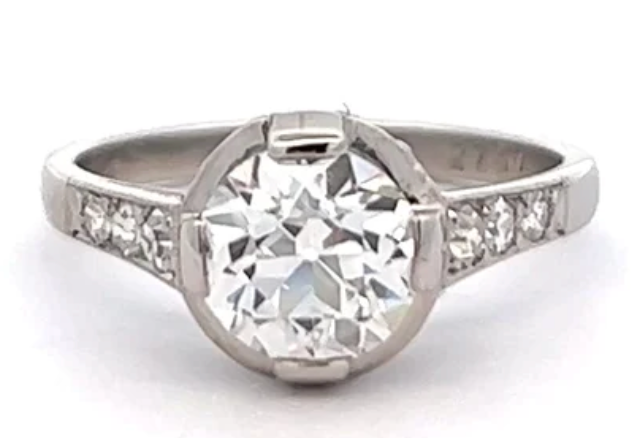
Jewelry never goes out of style; its timeless appeal spans century after century and is influenced by stylistic trends that ebb and flow. Let’s take a walk through a timeline of antique jewelry from the Georgian period to Art Deco, with the inclusion of some special Jack Weir & Son pieces. Maybe you’ll fall in love with a little piece of history that you can keep for yourself or gift to a loved one!
The Georgian Period (1714-1830) birthed a whirlwind of blossoming design aesthetics, including Rococo, Romanticism, and Neoclassicism. This exciting era of change resulted in Georgian stylistic influence reaching far and wide, from America to various places in Europe.

King George I of Great Britain
Before the mid-1700s, jewelry was not widely available and was reserved for aristocrats or high-society individuals. The beginning of the period was categorized by ornate, flamboyant jewelry that was manufactured into complex designs. Large stones and diamonds were the most sought after stylistically.
FUN FACT: Glass paste was created and sometimes utilized as a substitute for real stones in a response to the high demand.
Here’s a Georgian piece from our collection:
The Victorian Period (1837-1900) was a time of immense industrialization that created new opportunities surrounding mass production. It began and ended with the reign of Queen Victoria and was most well-known for immense contributions to style, fashion, decoration, and art trends.

Late Victorian women's fashion
Because of the Industrial Revolution, various craft items (including jewelry) did not need to be handmade anymore. However, more sentimental pieces are often part of the Romantic period, a sub-era reflecting love for Queen Victoria and her husband. Brooches were popular during both the Victorian and Romantic Periods. Popular gemstones include ruby, emerald, diamond, amber, and amethyst. Popular cuts include rose cut (rounded shape), cabochon (rounded top and flat bottom).


Art Nouveau “whiplash curves”
Here is an example from our collection:
Pastel colors were fashionable at the time, and this new style of jewelry fit the aesthetic perfectly. Changing necklaces birthed a need for necklaces featuring a gemstone, known as lavalliere.

Pendants were usually circular and coupled with motifs that featured different shapes and garlands. Platinum featuring diamonds and pearls were extremely popular.
Old Cut European diamonds predate the round cut diamond, which is one of the most popular diamond cuts today. Most were hand-crafted at the time, as this was before the integration of machinery and industrialization. This style was developed in Europe due to jewelers' desire to maximize carat weight. Because they were cut by hand, no two diamonds are exactly the same. This sets them apart from modern day diamonds, which are uniformly cut and produced. Here are some in our collection:
The Art Deco Period is renowned for its jazzy, spirited fashion and lifestyle trends after periods of industrialization and war. Most people think of the Great Gatsby aesthetic: flapper girls, extravagant parties, gold and black, pearls galore. It was a time of carefree celebration, and the freedom resulted in unique jewelry that is still replicated in design choices today.
In this period, bracelets became more popular as well as stacking/layering. They would often layer them like sleeves and were incorporated into popular fashion. Here is an example of an Art Deco bracelet you can call your own:
FUN FACT: Calibre cut stones are faceted gemstones that line up perfectly! They can be configured into different shapes depending on the desired look. Emeralds were commonly used for this technique.
It is difficult to find authentic, original jewelry pieces like the ones featured in this blog. This is why we recommend working with a trustworthy dealer who can help you find the piece you’ve been dreaming of. Here at Jack Weir & Sons we’ve spent the last 40 years traveling to Europe and all over the world, curating extraordinary estate jewels. JWS is where the old world meets the new world. Celebrate life, preserve history, discover your own priceless heirloom jewel. We offer in-person and Virtual Appointments and are happy to answer any questions about your favorite jewel.















































